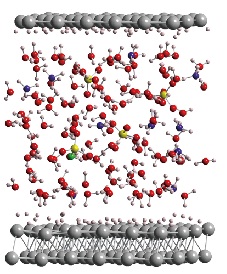Large-scale calculations for basic processes in fuel-cell related materials
Interviewee:
|
Interviewer:
|
| Associate Professor, Institute for Solid State Physics, The University of Tokyo |
CMSI Molecular Science Division Researcher |
Present status and problems in the area of fuel cells
Jono: The K computer is a massively parallel supercomputer made up of some 83,000 nodes, enabling it to handle more realistic environments than less powerful computers. Conversely, this may create new problems that have not been seen in model calculations up to now. What kind of problems do we face in terms of methodology in the area of fuel cells?
Sugino: Now that we are able to directly calculate large-scale systems, it is possible to reveal and explore electrode interfaces. What is important here is that, unlike ordinary reactions that take place in a solution, voltage is applied when chemical reactions at the electrode interface are simulated, so the effect of the electrical field must be taken into consideration. Up to now, however, not much attention has been paid to creating realistic environments around molecules. Techniques for conducting simulations at a fixed voltage at electrode interfaces in particular must also explain the phenomena that occur at the actual device interface. Our group developed a method called the Effective Screening Method (ESM) for conducting simulations with the voltage held to a constant level, and we have incorporated it into many simulation packages. Combining this method with other techniques for the calculation of statistics makes it possible to calculate various kinds of physical quantities at electrode interfaces under the applied voltage.
Jono: The ESM method makes it possible to accurately depict electrode interfaces for the first time. What problems currently need to be resolved with regard to the electrode interfaces used in fuel cells?
Sugino: In a nutshell, I'd say it's the "element strategy" for platinum substitutes. However, this will not be easy to achieve. First, the phenomena that are actually occurring must be reproduced by means of calculations, and the reaction mechanism will have to be understood. Only then can substitute metals be proposed. Electrochemical experiments are being performed to investigate in detail the reaction at the platinum electrode surface at which hydrogen is decomposed. This is ideal for verifying the accuracy of our calculations. Based on preliminary calculations, we have confirmed that, by placing water molecules up to approximately one nanometer from the platinum surface, it is possible to reproduce the properties of both the bulk water and the water near the surface, and that by conducting the simulation for 100 picoseconds or more, the recombination of the hydrogen bonds can be observed. From calculations performed on the K computer based on these findings, we think it will be possible to calculate various physical quantities at electrode interfaces using the methodologies developed up to now, and we plan to show that these can be accurately reproduced.
Collaboration with experimental scientists
Jono: The question of what physical quantities can be calculated through the use of the K computer is an important one for many fields, not only fuel cells. Now that experimental scientists themselves have begun to perform calculations, I think the creation of a system by which, in five or ten years when many researchers are given easier access to the K computer, researchers will not have to begin by developing new methodologies but will instead be able to start right in on scientific and technological research, is an important task in terms of improving the environment. The search for platinum substitutes is one of the most important research topics in the Element Strategies Initiative. Could you talk a little about the collaboration system for this effort at CMSI?
Sugino: In order to show that calculations can be used to accurately reproduce experimental phenomena, communication with experimental scientists will be essential. Also, rather than just considering ideas for platinum substitutes within CMSI, it would be more efficient to conduct the design based on a variety of opinions. We plan to hold exchanges of views through regular interchange with company researchers and collaboration with the Element Strategies Initiative.
Jono: Finally, could you talk about the future prospects for this research?
Sugino: From now on, large-scale experiments using synchrotron radiation, lasers, neutrons and so on will be conducted for interface systems. Measurements that take a close look at interfaces will be conducted repeatedly, and static atomic structures and dynamic processes will be made clear. As a result, I think fields such as microscopic electrochemistry will be developed, and these will produce new fusion domains of science and will lead to applications that we cannot even begin to foresee yet. The theory, too, will have to delve into areas such as excitation, nonequilibrium, ultra-high precision and so on if it is to be able to explain the experiments that are being performed. And I think computational theory, the evolution of computers and the development of algorithms will become even more important.
|
|
| The poliovirus and the D1 and D2 domains of the CD155 receptor. The water molecules used as a solvent have been removed from the image. (1 atmospheric pressure, 37°C) |




